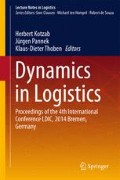Abstract
Since climate change has already threatened the whole ecological environment worldwide as well as the living surroundings of human beings, positive actions and regulations from governments are proposed and put into practice before the situation reaches the extreme situation in the near future. Among them, the EU-emission trading scheme (EU ETS) offers probably one of the most cost-efficient solutions for companies to realize greenhouse gas emission reduction. In this context, manufacturers and other companies included in ETS are confronted with the trade-off between carbon abatement cost and carbon allowance purchasing cost. The logistics sector, maintaining close business relationships with almost every industrial sector, is not yet directly included into ETS so far but still faces to the challenge of green reformation required by its customers from the manufacture industry and so on. A new market competition is aroused not only in inclusive manufacture industry but also in the logistics sector. This paper is going to introduce the ETS-impacted logistics sections, to discern both challenges and opportunities for logistics providers, and finally to propose effective measures against the current dilemma.
Access this chapter
Tax calculation will be finalised at checkout
Purchases are for personal use only
References
Abdallah T, Farhat A, Diabat A, Kennedy S (2012) Green supply chains with carbon trading and environmental sourcing: formulation and life cycle assessment. Appl Math Model 36:4271–4285
Chaabane A, Ramudhin A, Paquet M (2012) Design of sustainable supply chain under the emission trading scheme. Int J Prod Econ 135:37–49
EC Climate Action (2013) The EU-emissions trading system (EU ETS). Available at http://ec.europa.eu/clima/policies/ets/
Erdmenger C (2003) Buying into the environment: experiences, opportunities and potential for eco-procurement. Greenleaf Publishing
Geffen C, Rothenberg S (2000) Suppliers and environmental innovation. Int J Oper Prod Manage 20(2):166–186
Hawks K (2006) What is reverse logistics? Reverse Logistics Magazine. Winter/Spring
Pishvaee MS, Razmi J (2012) Environmental supply chain network design using multi-objective fuzzy mathematical programming. Appl Math Model 36:3433–3446
Ramudhin A, Chaabane A, Kharoune M, Paquet M (2008) Carbon market sensitive green supply chain network design. In: IEEE international conference proceedings on industrial engineering and engineering management (IEEM), pp 1093–1097
Sadegheih A, Li D, Sribenjachot S, Drake PR (2010) Applying mixed integer programming for green supply chain management. S Afr J Ind Eng 21(2):13–24
Sarkis J (2003) A strategic decision framework for green supply chain management. J Clean Prod 11(4):397–409
Sheu JB, Li F (2013) Market competition and greening transportation of airlines under the emission trading scheme: case of duopoly market. Transp Sci. doi:10.1287/trsc.2013.0473
Sheu J, Chou Y, Hu C (2005) An integrated logistics operational model for green-supply chain management. Transp Res Part E: Logistics Transp Rev 41(4):287–313
Simpson D, Power D (2005) Use the supply relationship to develop lean and green suppliers. Supply Chain Manage: Int J 10(1):60–68
Wang F, Lai X, Shi N (2011) A multi-objective optimization for green supply chain network design. Decis Support Syst 51:262–269
Zhu Q, Geng Y (2006) Green purchasing in Chinese large and medium-sized state-owned enterprises. Greening the Supply Chain 173–187
Author information
Authors and Affiliations
Corresponding author
Editor information
Editors and Affiliations
Rights and permissions
Copyright information
© 2016 Springer International Publishing Switzerland
About this paper
Cite this paper
Li, F., Haasis, HD., Dovbischuk, I. (2016). Challenges and Solutions Toward Green Logistics Under EU-Emission Trading Scheme. In: Kotzab, H., Pannek, J., Thoben, KD. (eds) Dynamics in Logistics. Lecture Notes in Logistics. Springer, Cham. https://doi.org/10.1007/978-3-319-23512-7_39
Download citation
DOI: https://doi.org/10.1007/978-3-319-23512-7_39
Published:
Publisher Name: Springer, Cham
Print ISBN: 978-3-319-23511-0
Online ISBN: 978-3-319-23512-7
eBook Packages: EngineeringEngineering (R0)

